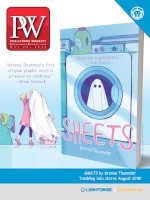Founded in 2012 as a digital-first comics publisher, St. Louis–based Lion Forge is relatively new on the graphic novel publishing stage. But over the past two years, the house has aggressively added staff and new publishing lines aimed at children, young adults, and older readers, in an expansion that is also aimed at the library market. In conversations with PW, Rich Johnson, Lion Forge’s v-p of sales, marketing, and business development, and Andrea Colvin, Lion Forge’s editor-in-chief, detailed the publisher’s efforts to support librarians and grow its presence in the library and school market.
Lion Forge is a new kind of graphic novel publisher structured to publish into both the book trade and the traditional comics shop market. The house publishes through its adult Lion Forge and Magnetic Press imprints, and for young readers, via its Cub House (middle grade) and Roar (YA) graphic novel imprints. Lion Forge also publishes Catalyst Prime, a line of superhero comics and graphic novels featuring a culturally and socially diverse lineup of characters.
“We’re a new age company, and we’re focused on best practices for both the book trade and comics publishers when it comes to libraries,” Johnson says. He outlines the range of Lion Forge’s library-focused activities. The house already exhibits at ALA conferences (bringing in Lion Forge authors), in addition to providing physical and digital advance galleys to librarians and using social media and graphic novel webinars in support of library/graphic novel events. Johnson also emphasized Lion Forge’s promotional outreach and targeted advertising support for trade publications aimed at the library market and the retail book trade.
Colvin notes that the championing of graphic novels by libraries has aided the discovery of titles. “Comics are more accepted in schools, and this started with librarians,” she says, adding that “libraries legitimize the medium, and they spread the word about comics to new readers.”
Colvin emphasizes the addition of educators and librarians to the staff at Lion Forge. Jill Gerber, an eighth grade teacher who uses graphic novels in her classes, has worked as an educational consultant to Lion Forge; she will join the publisher full-time on June 1 as its newly appointed director of educator outreach and collections, with a focus on libraries as well as on the use of comics in classrooms.
Literacy academic Kate Monnin, associate professor of literacy at the University of North Florida and the author of a variety of works on graphic novels and literacy, has worked on teacher guides for Lion Forge.
And former Lion Forge social media and marketing manager Christina Stewart (aka Steenz) switched jobs within the company earlier this year and is now an associate editor. Stewart also happens to be a comics creator herself, as well as a former librarian, who “has a great network of librarians” that she keeps updated on comics, Colvin says.
Though kids and young adult graphic novels have been embraced by librarians, some adult librarians remain skeptical. Colvin says that the category’s acceptance by adults will grow, and it “all depends on the books.” She adds, “There’s so many nonfiction and literary works. It’s a broad medium and [nonfiction literary works] are the entry points for graphic novels in libraries for the adult reader.”
Graphic Novels in Libraries: Graphic Novels Get Biblio-graphic



 Volume 265
Issue 22
05/28/2018
Volume 265
Issue 22
05/28/2018





